
Courtesy of Getty Images.
Latest News
January 12, 2024
As we reach the end of 2023, Digital Engineering has asked its readers once again to provide insight into their use of design and simulation technology.
Economic indicators heading into the new year have improved, with inflation subsiding, unemployment low and supply chain issues stabilizing. However, global instability and a volatile political environment in the United States may affect conditions. In general, demand seems to be strong for design and simulation software based on earnings reports from most of the major vendors. While demand for workstations has dropped back to prepandemic levels, companies like NVIDIA are reporting massive revenue gains. The additive manufacturing remains in flux, with a lot of merger/acquisition activity, but declining sales, for some vendors.
The big story this year, both in the press and in our survey results, is the emergence of artificial intelligence (AI) and machine learning (ML) in design and simulation workflows.
We received responses from more than 200 readers. The largest group of respondents described their primary role as product or system design engineering (32%), followed by engineering management (13%), research & development (12%) and corporate management (9%). Respondents were spread among market sectors, with the majority working in aerospace/aviation/defense, industrial machinery and products, electronic products and equipment, and automotive.
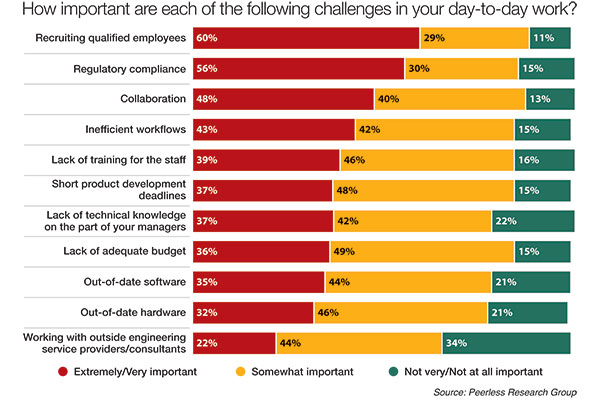
Staffing Challenges Persist
Recruitment emerged as the biggest challenge cited by our readers, and was considered an extremely or somewhat important challenge by 89% of respondents, up from 85% last year and supplanting collaboration (which dropped to second place at 88%). Inefficient workflows were the third most common challenge (85%). Regulatory compliance, short development deadlines and lack of budget tied for fourth place in the ranking.
This is our third year asking readers about the importance of sustainability in design. In the current survey, 31% of respondents said that sustainability was extremely important in their design/engineering activities, compared to 35% in 2022 and 30% in 2021. Fifty percent consider it somewhat important (compared to 46% last year). Just 19% said sustainability was not important at all.
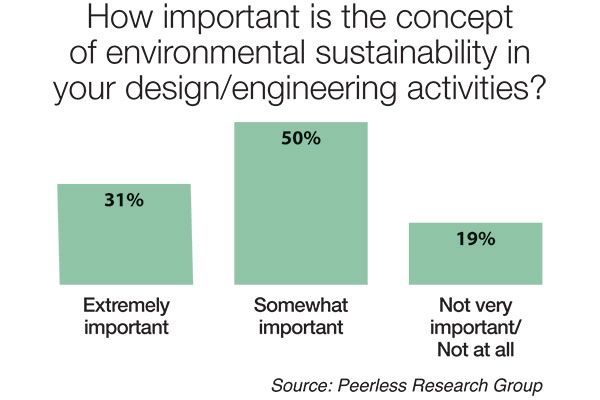
Below are a few representative reader comments from respondents that cited sustainability as very important.
- “First, because it’s the right thing to be doing. Second, it’s been part of our DNA from the beginning — none of our end products ends up on the scrap heap and we’re sustainably sourcing 90% of our raw materials already. This is just a continuation of our environmental-first philosophy.”
- “My organization designs and fabricates semiconductors. The concept of environmental sustainability is extremely important in my design and engineering activities. I believe that it is important to design and engineer products that are environmentally friendly and that minimize their impact on the planet. There are a number of ways that I can incorporate environmental sustainability into my design and engineering work. For example, I can: Use sustainable materials in my designs. Design products that are energy-efficient. Design products that can be recycled or reused, minimizing e-waste. Design products that have a low carbon footprint.”
Artificial Intelligence Is On Everybody’s Mind
When we have previously asked which technologies readers thought would have the biggest impact on product development in the next 5 years, AI and additive manufacturing have traded the No. 1 and No. 2 spots for several years. This year, however, AI was the clear winner in this category, with 65% of respondents citing it as the technology to watch, compared to 42% last year. Simulation was a distant second at 38%, followed by additive (37%), predictive analytics (33%), and high-performance computing (31%).
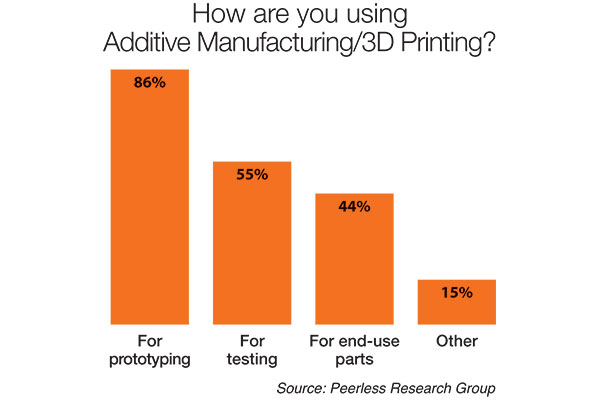
AI, of course, has been big news across industries thanks to the emergence of ChatGPT and controversies around AI being used for everything from writing term papers and novels, to creating images and even generating impossible music mash-up videos and entire songs. In engineering, new tools have emerged to help engineers explore the design space using AI and perform rapid simulation and analysis.
Generative design, which had dropped to 19% on this list last year, rose back up to 29% in the current survey.
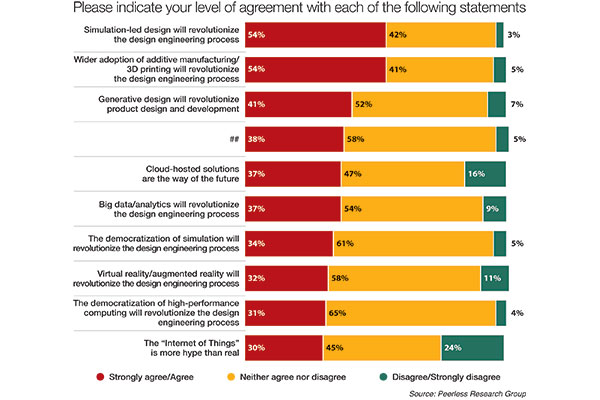
Reader comments indicated a wide variety of opinions on AI, from highly enthusiastic to cautious. A few examples:
- “AI and ML have their place and their uses, which I believe are expanding every day. We are not yet at a place to adopt AI/ML into our design and development process, but I would like us to. I feel that some large OEMs, including ours, may be a bit hesitant to adopt AI/ML out of fear of cybersecurity issues and where the computing is happening (on a cloud server that may not be completely secure).”
- “Applied AI trained on specific data sets will result in an exponential increase in productivity. Combined with generative solutions, the partnership between AI and engineering will provide cost-effective solutions and increase profits on many fronts: by reducing R&D time, by improving development efficiencies, by intelligent management of supply chains, better customer service, and many others.”
- “Continued advances in computing power and BIG data will change products in ways that we haven’t imagined.”
- “Lots of promise, but we’re in a major hype cycle right now that seems unlikely to abate for some time. Part of the problem is that ‘AI/ML’ is so broad that discussions about it cease to be meaningful if they aren’t heavily restricted to specific types. I think the biggest impact on the simulation side will be Physics-informed Neural Networks (PINNs), which could dramatically reduce the time to a solution with little to no loss of accuracy.”
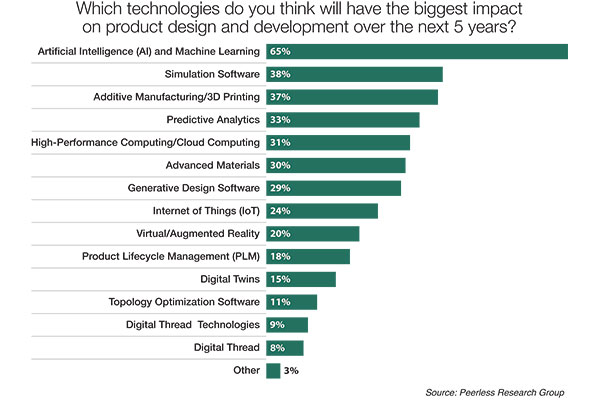
- “My organization designs semiconductors for a wide range of use cases. I can use AI to generate a large number of design ideas for a new product, based on my understanding of user needs and market trends. In turn, this can help me to identify and select the best design for my product. Moreover, I can use AI to optimize my design process by automating tasks such as generating technical drawings and creating prototypes. This can free up my time to focus on more creative and strategic aspects of product design. In addition, I can use AI to create products that are tailored to the needs of individual users. Lastly, I can use AI to develop new products and services that are tailored to the needs of specific user groups. For example, I could use AI to develop new medical devices or educational software.”
- “I have very positive impressions of AI and machine learning. I believe that these technologies have the potential to revolutionize many industries, including product design and development. AI and machine learning can be used to automate tasks, improve decision-making, and create new products and services. For example, AI can be used to generate design ideas, optimize manufacturing processes and predict customer demand. In my own product design and development, I believe that AI and machine learning can be used to: Generate more creative and innovative design ideas. Optimize my design process to be more efficient and effective. Create more personalized and user-friendly products. Identify and mitigate potential problems early on in the design process. Develop new products and services that meet the needs of my users in new and innovative ways.”
Simulation Leads the Way
As in previous surveys, we asked readers what technologies they were currently using or developing products for, as well as which technologies they expected to adopt in the next 2 years. Simulation software once again ranked as the top technology that most readers were currently using, with 50% reporting that they were doing so (down from 53% last year). Additive manufacturing/3D printing was second again at 43% (up from 42%).
Those were followed by product lifecycle management (PLM; 38%), IoT (28%), advanced materials (28%) and predictive analytics (24%).
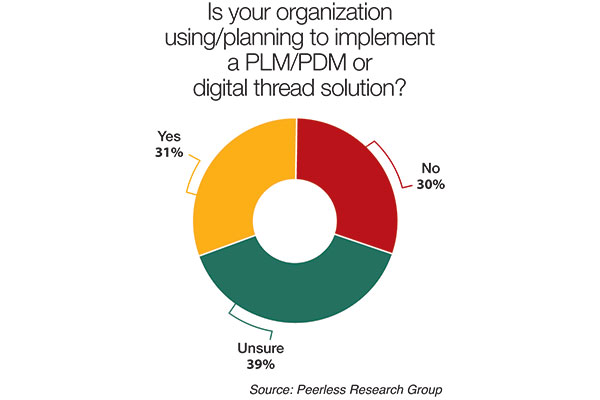
In the next 2 years, 35% of respondents plan to incorporate AI/machine learning in their design/development processes, with 24% planning to use both HPC/cloud computing and predictive analytics. Generative design was the third-ranked category for future use (22%), followed by simulation (21%), advanced materials (20%) and augmented/virtual reality (20%).
Additive Manufacturing Trends
The number of additive manufacturing users that focus primarily on prototyping dropped slightly this year to 86% from 89%. Testing applications were down slightly from 56% in 2022 to 55% this year. End-use part printing rose from 42% of current users to 44%.
The cost justification for additive manufacturing shifted significantly in the current survey with 72% of respondents citing discovering new designs as a top objective, followed by shortening product development schedules (67%), improving quality (65%) and fostering innovation (61%) tied with productivity (also 61%). Reducing development costs, which was the second-ranked category last year, dropped all the way down to sixth place.
Generative Design Still Waiting in the Wings
While interest in AI is expanding quickly, its algorithmic cousin in engineering, generative design, is still stalled among our readers. Only 14% reported that they are currently using generative design, down from 16% last year. In the future, 22% of respondents plan to deploy generative design, down from 24% last year.
Satisfaction with generative design among current users was high for helping engineers be more productive, with 69% of users again saying they were extremely/very satisfied with the technology’s performance. Fifty-four percent of users were also extremely satisfied with the technology’s ability to shorten product development schedules, reduce product manufacturing costs, reduce weight, foster innovation and discover new designs — results that were flat compared to last year.
Thoughts on generative design were mixed.
A few user comments:
- “Generative design will be the standard for the future, but we don’t build physical components requiring this level of optimization.”
- “I have a positive impression of generative design software. I believe that this technology has the potential to revolutionize product design and development. Generative design software uses artificial intelligence and machine learning to generate a large number of design options, based on a set of constraints and requirements. This can help engineers to find the best design for their needs, more quickly and efficiently than traditional design methods.”
- “I think, much like I’ve seen when FEA is used incorrectly, it will allow inexperienced engineers to be confident in designs they shouldn’t be. I think it should be used to free up time for experienced engineers, it will likely be seen by executives and be used to cut out experienced engineers.”
- “It’s a way of augmenting designers’ capabilities for exploring the design space more efficiently. It’s expected to result in designs that are lighter-weight, stronger, and less materials-intensive, and designs that take advantage of unique structures possible with additive manufacturing that are difficult/impossible with traditional manufacturing technologies.”
Digital twins appear to be treading water a bit, with 54% of respondents reporting that they know what a digital twin is (compared to 56% last year). More readers claim to be unfamiliar with digital twins (30%, compared to 21% last year). Reported use of digital twins grew slightly from 13% to 14%, with those planning to deploy the technology in 2 years dropping from 25% to 18%.
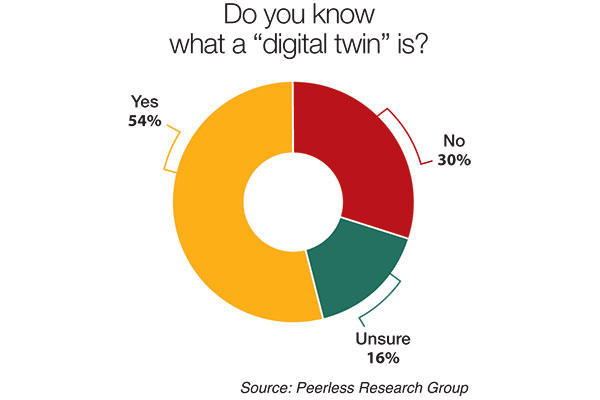
Additive and Simulation Get High Marks
When asked what technologies would revolutionize the design engineering process, 54% strongly agreed that it would be additive manufacturing/3D printing (compared to 58% last year). Simulation-led design tied with additive at 54%. At third, generative design was cited by 38% of respondents.
Asked about familiarity with various technologies, simulation again led with 83% of respondents being very or somewhat familiar, followed by additive manufacturing (80%), product lifecycle management (PLM) (75%) and the Internet of Things (72%).
Readers were least familiar with digital thread technology (32% claimed to not be familiar with it at all). Topology optimization and digital twins also had very low reader familiarity.
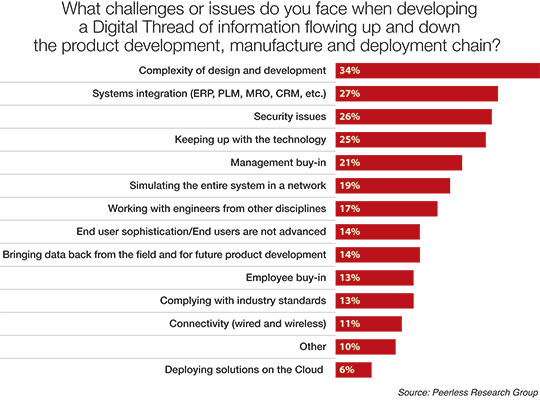
More NVIDIA Coverage
Subscribe to our FREE magazine, FREE email newsletters or both!
Latest News
About the Author
Brian Albright is the editorial director of Digital Engineering. Contact him at [email protected].
Follow DERelated Topics






